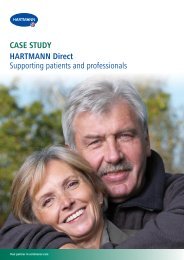Download - Paul Hartmann AG
Download - Paul Hartmann AG
Download - Paul Hartmann AG
You also want an ePaper? Increase the reach of your titles
YUMPU automatically turns print PDFs into web optimized ePapers that Google loves.
60 Changing environmental needsA large part of HARTMANN sales are disposable products.By preventing and recycling waste and packaging, we helpto make the life cycle of our products as sustainable aspossible. Manufacturing, packaging, and distribution playan important role here.The most valuable waste is that which can be avoided.Development of waste amountrelated to consolidated salesin the HARTMANN GROUP*, in tons;index basis : December 31, 200713012011010090802007 2008 2009 2010100 197.1 88.8 87.3100 107.5 121.8 127.4tons/consolidated salesconsolidated sales* 32 production, logistics and administrative sites; of these in Europe: Germany, Belgium, France, Great Britain,Italy, Austria, Poland, Russia, Sweden, Switzerland, Spain, Czech Republic, Hungary; of these outside Europe:China, India, South Africa, USATo avoid waste from the beginning, we continually increase material efficiency(see page 44) of our products and our production. One significantoperational measure is to reduce the reject rate in our production. Wherewaste cannot be prevented, it is recycled or used to generate energy.Consolidated waste statistics from central production regionsThe total amount of waste in the HARTMANN GROUP* was about 27,000 tonsin 2010. Related to sales revenues, we have continuously reduced this quantitysince 2007. We have sent about 22,000 tons to recycling, a recyclingrate of 80 percent. The remaining waste was disposed of in accordance withregulations.More than 95 percent separation of cellulose and superabsorbersAt the Herbrechtingen location in Germany, we process about 2,000 tons ofproduction waste with a high degree of purity for recycling each year. Toachieve this, cellulose and superabsorber (SAP), the main components of theabsorbent core of HARTMANN incontinence products, have to be separatedfrom each other in a complex process. For this purpose, we operate a plantin Herbrechtingen, in which the compressed mass of cellulose pulp andSAP are completely separated. The process was jointly developed with atechnology partner. The purity of the processed SAP is equivalent to thestandard of new goods.












